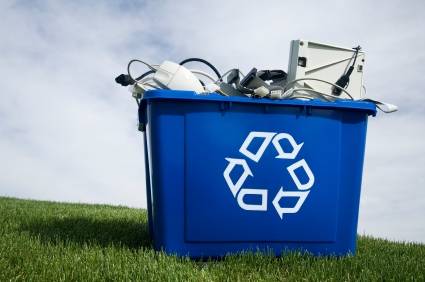SO YOU FINALLY got that upgrade you’ve been longing for or that must have computer gadget you didn’t think you could live without. It’s all unpacked and the only thing in the way of setting it up is your old dated machine it will be replacing. Doesn’t seem like a very big obstacle right? Well maybe not, but if you were planning on getting rid of it with the rest of your house hold refuse you should think again. This is not only extremely bad for the environment but actually illegal in many countries.
Electronic products contain a large number of toxic materials that can’t safely just be left in landfills. The average older monitor has around five pounds of LCD inside that if released into the environment can cause serious health problems for those living in the surrounding areas.
Before doing anything, though, you need to make sure your data are removed from the machine. It’s ironic—not to mention annoying—that hard drives are fragile enough to have spawned a whole back up industry and yet it’s virtually impossible to be sure your data are beyond recovery.
The good news is, though, that unless you’re guarding state secrets or a thief might have reason to think your data are valuable, almost any effort to delete data makes it more trouble than it’s worth to recover.
 For a computer or hard drive that no longer works: Remove the hard drive and physically destroy it. Hammers, drills and blow torches are just a few of the creative ways people have gone about this task. Popular Mechanics offers some amusing as well as useful tips in “How to Absolutely, Positively Destroy Your Data” (Feb. 2007).
For a computer or hard drive that no longer works: Remove the hard drive and physically destroy it. Hammers, drills and blow torches are just a few of the creative ways people have gone about this task. Popular Mechanics offers some amusing as well as useful tips in “How to Absolutely, Positively Destroy Your Data” (Feb. 2007).
For a computer that’s still working: If you’re planning to recycle the computer, you can either destroy the hard drive (see above) or wipe the whole disk clean using one of several free tools — Darik’s Boot And Nuke is a popular and fairly easy option, Active@Killdisk offers another, newer option that may be more user-friendly.
You can then safely dispose of old, broken or unwanted electronics at the annual free e-waste recycling event sponsored by the University of Michigan and Ann Arbor Public Schools.
The U-M Office of Campus Sustainability, which serves as the focal point for sustainable campus operations, is coordinating the three-day event open to the public, local businesses and nonprofits.
“Each year, thousands of people stop by to take advantage of this environmentally safe manner for disposing electronics,” said Andy Berki, manager of the Office of Campus Sustainability. “It’s exciting to see the community engaged in the proper disposal of their electronics and the effort to keep potentially harmful materials out of the landfills.”
An assortment of electronics will be accepted at the event, including laptops, desktops, televisions and telephones.
Collections will occur at Pioneer High School and at the U-M State Street Commuter Parking Lot.
Equipment drop-off times follow:
General public: 9 a.m.-2 p.m. Saturday, April 26, at Pioneer High School, 601 West Stadium Blvd. Enter from Main Street at the corner of West Stadium Boulevard.
Businesses and nonprofits: 9 a.m.-5 p.m. Thursday, April 24, and 7 a.m.-3 p.m. Friday, April 25, at the U-M State Street Commuter Parking Lot, 2694 South State St.
Register for the event here: http://michigan.poweron.com/p/register
Following collection, equipment is properly disassembled, shredded and recycled into raw materials by a fully licensed recycling facility in North America, and manufactured into new items.
Electronic waste is the fastest-growing type of waste worldwide and frequently contains hazardous materials like lead and mercury, which can adversely affect the environment and human health.
According to data provided through an e-waste initiative led by the United Nations, the U.S. is the world’s largest generator of electronic waste and created nearly 9.4 million tons in 2012; an average of 65 pounds per person.
Additionally, the U.S. Environmental Protection Agency estimates only 25 percent of electronics ready for end-of-life disposal are collected for recycling.
This is the seventh year the university and Ann Arbor Public Schools have sponsored the event. Since 2008, the event has filled a combined total of 106 semitrailers and diverted a total of 1,374 tons of electronic waste from local landfills.

